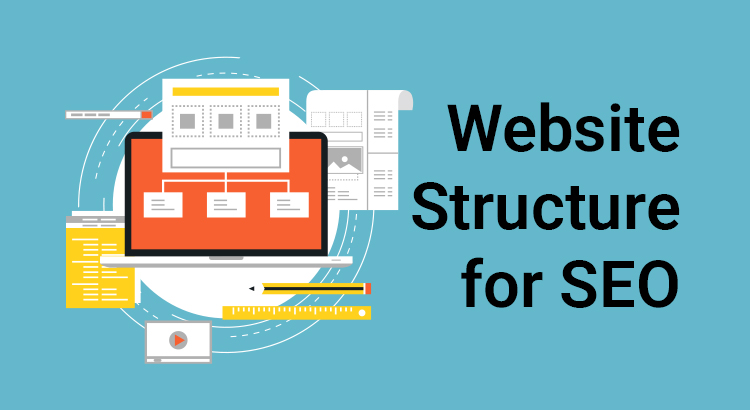Website structure for SEO provides a solid foundation for building a strong online presence. While SEO web design handles the visual aspects of the site, the structure defines how pages are interconnected and presented. This will impact the site’s search engine optimization performance. A well-optimized website structure is a critical technical SEO component, directly influencing discoverability and authority flow.
What Is Website Architecture?
Website architecture, or site structure, refers to how webpages are organized and connected within your domain. It outlines the hierarchy of your pages, how they interlink, and the flow from general to specific content. This isn’t just about how a site looks, it’s about how it functions for both users and search engines.
A strong layout includes effective use of internal links, structured navigation, and consistent categories. These elements ensure that search engine crawlers can efficiently scan and index your pages while making the visitor experience smoother and more intuitive.
Why Is Website Structure Important for SEO?
A logical site structure enhances how search engines understand your content. Here’s how an effective site layout impacts visibility and ranking:
1. It Helps Search Engines Find and Index Your Site’s Pages
Effective site architecture helps your pages rank. Google uses internal links to discover pages and add them to its index. Pages must be indexed to rank and drive traffic. An organized website structure helps Google follow these links, finding new pages and preventing “orphan pages” (pages with no internal links) that are hard to discover.
2. It Gives Search Engines Additional Context for Each Page
Site structure provides context, helping search engines understand page topics and match them with queries. For example, on an online bookstore site, internal links help search engines see which authors belong to “Fantasy Novels” or “Science Fiction.” Anchor text also reinforces this understanding, improving organic rankings for relevant searches. Without clear website organization, search engines may struggle to grasp page purpose, harming organic visibility.
3. It Spreads Authority Throughout Your Webpages
Website architecture optimization is vital for distributing PageRank (link equity). Pages with strong authority can pass some of that authority to internally linked pages. This boosts rankings for less authoritative pages, increasing organic traffic and overall SEO performance.
4. It Helps Visitors Find the Content They’re Looking For
A clear site structure significantly improves user experience (UX). Users prefer easy navigation, which increases engagement, reduces bounce rates, and boosts conversions. Planning your site hierarchy ensures users smoothly find products, services, or key information. Retailers like Target exemplify this with their logical product categories and user-friendly navigation.
What Does a Good Site Architecture Look Like?
A well-structured website balances simplicity and hierarchy:
1. Flat Website Architecture
This means users (and search engines) can access most content within three clicks from the homepage. It reduces crawl depth, enhances speed, and increases discoverability.
2. Group Topically Relevant Content Together
Pages should be clustered based on topics. This kind of topical grouping improves relevance, builds thematic authority, and provides a clear trail of navigation.
3. No Orphan Pages
Every page should be reachable through internal links. If a page exists in isolation, it can be ignored by crawlers and missed by users. Good architecture eliminates such dead ends.
9 Website Architecture Best Practices
A well-planned structure supports long-term search visibility and a better user journey. These best practices can guide your design:
1. Select the Appropriate Structure for Your Website
There is no universal website structure that fits every site. When planning your site hierarchy, carefully consider your site’s size, objectives, and target users. For example, an e-commerce site might effectively use product categories. On the other hand, a content-focused site could organize its information by topics.
For sites displaying many products or search results, pagination can be used to separate content across multiple pages. This method provides more internal linking opportunities, which helps search engines understand how your pages relate.
Content-driven websites structure their content based on broad categories. Also, studying how competitors organize their sites can be beneficial, as your audience may expect a similar, familiar structure for straightforward navigation.
2. Plan Your Site’s Information Architecture
Information architecture (IA) involves the strategic process of structuring your content effectively. A key strategy for this is employing content pillars alongside topic clusters.
Pillar pages focus on broad, overarching subjects, while topic clusters delve into more specific subtopics related to that main pillar. For example, if your pillar page addresses “fitness training,” cluster pages might explore ” beginner workout routines” or ” nutrition for active lifestyles.”
3. Utilize Internal Linking Strategically
Strategic internal linking is fundamental to a strong website structure. When you connect one page to another through links, you signal a clear relationship to both search engines and users.
It is advisable to position your highest authority pages higher in your site hierarchy. This allows them to effectively distribute their authority to other pages, enhancing overall SEO performance and improving the discoverability of your content.
4. Ensure Quick Access to Pages for Users
A core principle of good website architecture is ensuring that users can reach any page on your site in just a few clicks. Aim for a maximum of three clicks from your homepage to any desired content.
This practice not only significantly improves user experience by allowing faster navigation, but also makes your content more accessible and discoverable for search engine crawlers, leading to more efficient indexing.
5. Effectively Use Categories and Tags
For websites publishing blog posts or articles, utilizing categories and tags is an excellent way to group content by topic. This organizational structure significantly benefits both users and search engines.
Categories are designed to cover broad topics. For instance, a technology blog might have categories such as “Software Reviews,” “Hardware Guides,” and “Industry News,” with each potentially including subcategories like “Operating Systems” or “Gaming PCs.”
Tags often provide more specific classifications that can span across various categories. For example, an automotive blog might use tags like “electric vehicles” or “classic cars” to group posts for different enthusiast interests.
When selecting your blog categories, consider turning your most frequently covered topics into main categories, or drawing inspiration from your pillar page topics. Analyzing how other successful blogs organize their content can also guide your choices. Another approach is to organize content by type, such as “how-to guides” or “case studies.”
6. Optimize Your Site’s URLs
Optimized URLs are a significant component of SEO friendly website architecture. Google utilizes URLs to understand your page’s hierarchy and content. The most effective URLs are short, clear, and naturally incorporate your main keywords.
For example, a URL like yourwebsite.com/blog/best-gardening-tools is much better than a generic, uninformative one such as yourwebsite.com/pages/categoryID123/postID4567.
If you ever need to alter live URLs, it is crucial to implement proper 301 redirects. This preserves any existing link equity and ensures seamless user and search engine navigation.
7. Design an Intuitive Navigation Menu
Creating an easy-to-follow navigation menu is paramount for an effective website structure. Users consistently expect clear paths to key pages. Most websites implement a header (or top) navigation menu, a footer navigation menu, and a dedicated mobile navigation menu.
Additionally, some sites feature secondary or contextual navigation to enhance the user journey. The primary goal is to maintain simplicity in your navigation, enabling users to find crucial content rapidly.
Header Navigation:
This primary navigation resides at the top of your pages. Common styles include:
- Drop-down menus: These are highly effective for sites with substantial content, allowing many pages to be presented while still offering a direct path for the user.
- Horizontal menus: Well-suited for smaller websites, these should provide categories that users commonly anticipate.
- Vertical sidebar menus: While potentially offering more space for top-level navigation links, these can occupy valuable screen real estate and might obscure important content. If your site features numerous content categories, drop-down menus often serve as the most organized solution.
Footer Navigation:
Located at the bottom of websites, the footer navigation is an ideal space for links to less prominent yet necessary information, such as press details, policy documents, and contact pages. These links are useful but typically do not belong in the main header menu.
Mobile Navigation:
With Google’s emphasis on mobile-first indexing, clear mobile navigation is essential. Many sites utilize a common expandable menu icon to display the same main links found on desktop, ensuring a consistent and accessible user experience across various devices.
8. Implement Breadcrumbs
Breadcrumbs are small, text-based links that visually show a user’s location within your site structure, mapping their path. These navigation aids are not only helpful for users but also assist search engines in understanding how your website is organized.
By adding breadcrumb structured data markup, you enable these breadcrumbs to appear directly in search results. This makes it easier for users to navigate back through your site, especially after clicking into deeper content.
9. Utilize HTML and XML Sitemaps
Sitemaps are essential tools that present an organized overview of your site’s pages, images, and other files. Search engines rely on these sitemaps to efficiently discover and process new content on your website.
HTML sitemaps are designed for users. They provide a comprehensive list of every page, helping visitors locate content if they find themselves lost or unable to navigate through regular menus.
XML sitemaps, on the other hand, are specifically for search engines. They list all your website’s URLs in a format that is easily understandable by crawlers. To further enhance crawlability, you can create multiple XML sitemaps for different sections of your site, such as products, blog posts, or categories.
Summary
Website architecture for SEO is a foundational element of building a high-performing online presence. When your pages are logically structured, interconnected, and easy to access, it benefits both users and search engines. Focus on simplifying user navigation while ensuring search engines can efficiently interpret your structure.


